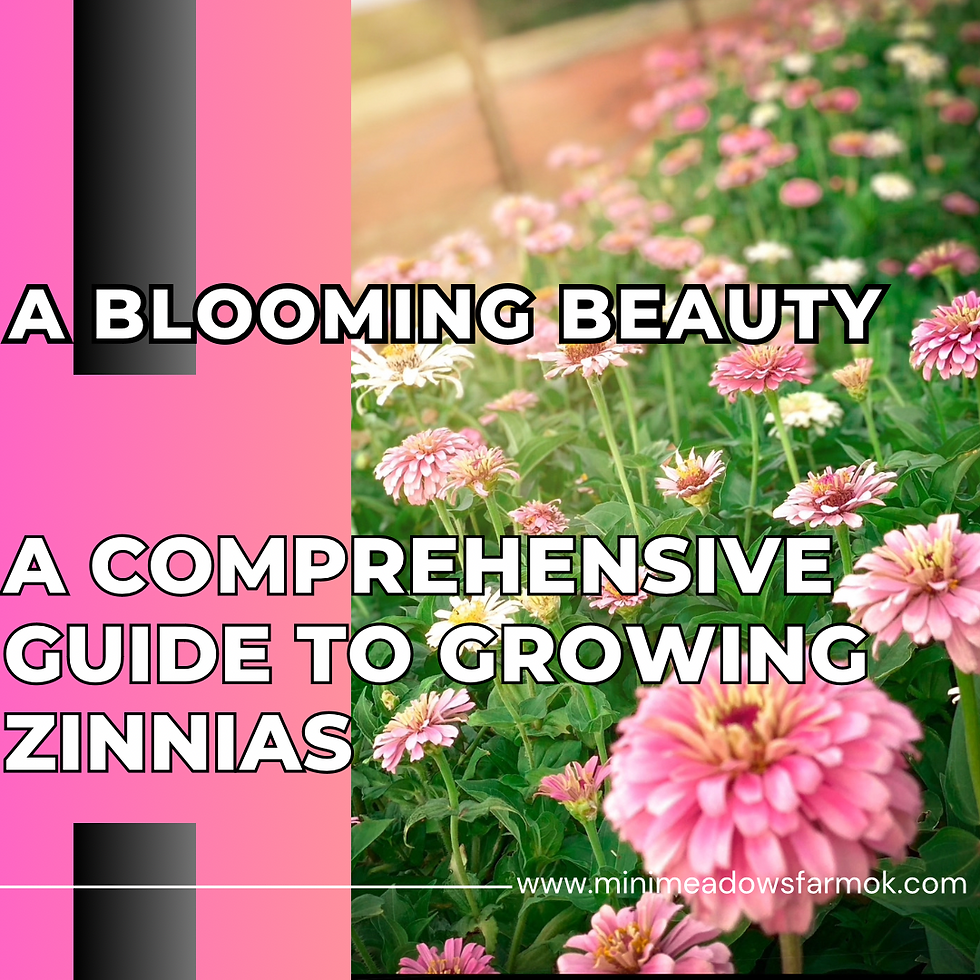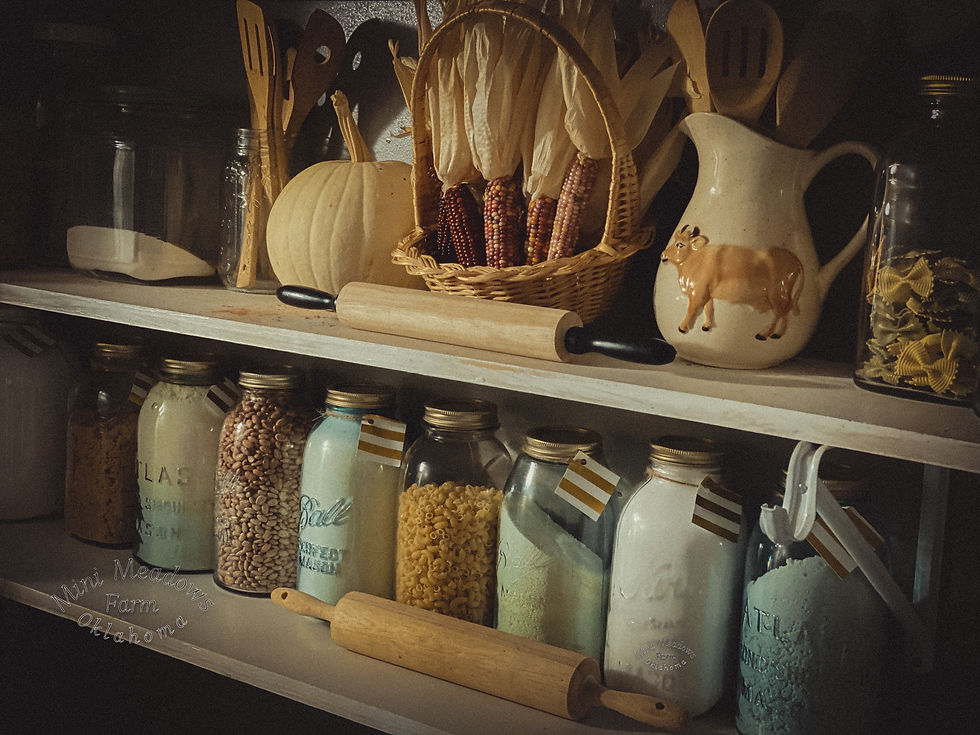A Blooming Beauty: A Comprehensive Guide to Growing Zinnias
- kimberkay777
- Aug 15, 2023
- 6 min read

Zinnias are vibrant and versatile flowers that have captured the hearts of gardeners around the world! In this article, we will dive into the history and origins of zinnias, their transformation over time, notable individuals and organizations involved, specific varieties and their characteristics, pest and disease resistance, planting and care instructions, the benefits they bring to YOUR landscape and vegetable garden, and seed-saving techniques. Let’s explore the beautiful and captivating world of zinnias!
1. History and Origins:
• Zinnias are native to the arid regions of Mexico and Central America.
• They were named after the German botanist Johann Gottfried Zinn.
• Initially, zinnias had limited color options, but breeding efforts expanded their palette.
2. Transformation and Influential Figures:
• The zinnia’s journey from its wild form to the wide array of cultivars we have today was influenced by horticulturists, breeders, and organizations.
• Individuals like Luther Burbank, Carl Linnaeus, and W. Atlee Burpee contributed to zinnia cultivation.
Luther Burbank (1849-1926):
Luther Burbank was a renowned American horticulturist and plant breeder known for his contributions to agricultural science.
While he didn't specifically work extensively on Zinnias, his innovative plant breeding techniques and experiments laid the groundwork for modern plant breeding practices.
His work on hybridization and selection techniques influenced plant breeding across various species, including flowers like Zinnias.
His methods of crossbreeding and selection contributed indirectly to the improvement of Zinnia varieties for characteristics like color, size, and disease resistance.
Carl Linnaeus (1707-1778):
Carl Linnaeus, a Swedish botanist, is considered the father of modern taxonomy.
While he didn't work directly with Zinnias, his system of binomial nomenclature laid the foundation for categorizing and naming plants, including Zinnias.
By assigning each plant a unique two-part scientific name, Linnaeus standardized the way plants are identified and communicated among botanists and horticulturists. This classification system facilitated the study, understanding, and cultivation of plants like Zinnias across the world.
W. Atlee Burpee (1858-1915):
W. Atlee Burpee was an American seed developer and founder of the Burpee Seed Company.
He is known for his significant contributions to the introduction and popularization of new and improved plant varieties, including Zinnias.
Burpee introduced new Zinnia varieties with enhanced colors, shapes, and sizes, making them more attractive to gardeners.
He was instrumental in disseminating these improved Zinnia seeds to a wider audience through his seed catalog and distribution network.
Burpee's efforts helped transform Zinnias from simple wildflowers to a diverse range of cultivated ornamental plants.
So to sum it all up, Luther Burbank's breeding techniques indirectly influenced Zinnia improvement, Carl Linnaeus's taxonomy system standardized their classification, and W. Atlee Burpee's seed company played a vital role in introducing and popularizing enhanced Zinnia varieties, contributing to the transformation and cultivation of the Zinnia flower as we know it today!
3. Varieties, Colors, and Characteristics:
10 popular varieties of zinnias, along with their unique colors, size, and characteristics:
1. Zinnia elegans 'Benary's Giant'
- Colors: Various shades including red, orange, pink, and white.
- Size: Large, double blooms measuring around 4-6 inches in diameter.
- Characteristics: Tall and vigorous plants, excellent for cut flowers, long-lasting blooms, and strong disease resistance.
2. Zinnia elegans 'State Fair'
- Colors: A mix of bright and pastel colors.
- Size: Large, semi-double to fully double flowers with diameters around 4-6 inches.
- Characteristics: Robust plants with uniform growth, great for exhibition purposes, and a variety of colors in one package.
3. Zinnia elegans 'Cut and Come Again'
- Colors: Mixed colors including vibrant pinks, oranges, and yellows.
- Size: Semi-double to fully double blooms, 2-3 inches in diameter.
- Characteristics: Compact plants with prolific blooming, ideal for cutting and the flowers reappear after cutting.
4. Zinnia angustifolia 'Crystal White'
- Color: Crisp white.
- Size: Small, daisy-like single blooms around 1-2 inches in diameter.
- Characteristics: Low-growing, heat-tolerant plants, suitable for borders, rock gardens, and containers.
5. Zinnia haageana 'Mexican Flame'
- Colors: Warm shades of red, orange, and yellow.
- Size: Small, dahlia-like double blooms, about 1-2 inches in diameter.
- Characteristics: Compact plants with an abundant display of colorful blooms, great for attracting pollinators.
6. Zinnia marylandica 'Profusion Series'
- Colors: Wide range including pink, orange, cherry, and white.
- Size: Compact plants with single to semi-double blooms, around 1-2 inches in diameter.
- Characteristics: Disease-resistant, heat-tolerant, continuous blooming, and well-suited for containers and landscapes.
7. Zinnia 'Queen Lime'
- Color: Unique pale lime-green blooms that mature to a soft pink.
- Size: Semi-double flowers with a diameter of about 2-3 inches.
- Characteristics: Distinct color-changing flowers, great for adding interest to floral arrangements.
8. Zinnia elegans 'Cactus Flower'
- Colors: Mixed vibrant shades.
- Size: Double blooms with long, tubular petals resembling cactus flowers, around 4-5 inches in diameter.
- Characteristics: Unique flower form, eye-catching and textural appearance, suitable for cut flowers.
9. Zinnia 'Envy'
- Color: Rich, deep green blooms.
- Size: Fully double flowers measuring about 2-3 inches in diameter.
- Characteristics: Unusual green color, excellent for contrasting with other blooms in arrangements.
10. Zinnia 'Uproar Rose'
- Color: Vibrant rose-pink.
- Size: Semi-double to fully double blooms, around 2-3 inches in diameter.
- Characteristics: Disease-resistant, compact growth, and consistent blooming throughout the growing season.
These varieties showcase a wide range of colors ranging from vibrant oranges, pinks, and reds to soft pastels.
Their sizes vary from large double blooms to compact varieties like ‘Thumbelina’ that are perfect for containers, while taller varieties add drama to borders! These versatile and unique features, make them popular choices for gardeners looking to add diversity and vibrancy to their zinnia displays!
4. Pest and Disease Resistance:
Zinnias can be susceptible to various pests and diseases. Here are some common ones and tips on how to protect and prevent them:
Pests:
1. Aphids: Use insecticidal soap or neem oil to control aphid infestations. Encourage natural predators like ladybugs and lacewings.
2. Spider Mites: Spray plants with water to dislodge mites. Apply neem oil or insecticidal soap to control severe infestations.
3. Whiteflies: Use yellow sticky traps to monitor and control whiteflies. Introduce natural enemies like parasitic wasps.
4. Caterpillars: Handpick caterpillars or use Bacillus thuringiensis (Bt) insecticide for control.
Diseases:
1. Powdery Mildew: Provide good air circulation, avoid overhead watering, and use fungicidal sprays containing sulfur or potassium bicarbonate.
2. Botrytis Blight: Remove infected plant parts promptly and avoid overhead watering. Apply fungicides as a preventive measure.
3. Downy Mildew: Ensure proper spacing between plants, provide good ventilation, and apply copper-based fungicides.
4. Fusarium Wilt: Plant zinnias in well-draining soil and avoid overwatering. There's no cure for infected plants, so remove and destroy them.
5. Rust: Remove infected leaves and destroy them. Apply fungicides with copper or neem oil.
Prevention and General Tips:
1. Healthy Soil: Start with well-draining soil and proper fertilization to promote plant health.
2. Spacing: Plant zinnias with adequate spacing to prevent overcrowding, which can lead to increased disease spread.
3. Watering: Water at the base of the plant early in the day to allow foliage to dry before nightfall, reducing the risk of fungal diseases.
4. Sanitation: Regularly remove dead or diseased plant material to prevent the spread of pests and diseases.
5. Mulching: Apply a layer of mulch to prevent soil-borne diseases from splashing onto the plants during rain.
6. Resistant Varieties: Choose zinnia varieties that are resistant to specific diseases if available.
7. Crop Rotation: If you're planting zinnias annually, avoid planting them in the same spot each year to minimize disease buildup.
By following these tips and closely monitoring your zinnia plants, you can help keep them healthy and vibrant while minimizing the impact of pests and diseases.
• Disease-resistant varieties include ‘Zahara’ and ‘Profusion’ series, known for their resistance to powdery mildew and leaf spot.
5. Drought Tolerance:
• Zinnias are known for their ability to tolerate dry conditions once established.
• Varieties like ‘Zahara’ and ‘Profusion’ are particularly drought tolerant.
6. Planting and Care Instructions:
• Start zinnias from seeds indoors, or sow them directly into the ground after the last frost date.
• Choose a sunny location with well-drained soil.
• Plant seeds or seedlings at a spacing appropriate for the variety, usually around 6 to 18 inches apart.
• Water regularly, aiming for an inch of water per week.
• Deadhead spent flowers to encourage continuous blooming.
7. Benefits in the Landscape and Vegetable Garden:
• Zinnias attract pollinators like butterflies and bees, enhancing biodiversity in your garden.
• Their bright colors add vibrancy and visual interest to landscapes.
• Planting zinnias alongside vegetables can provide a natural pest deterrent.
8. Seed-Saving Techniques:
• Allow zinnia flowers to fully mature and dry on the plant.
• Collect the seeds from the dried flower heads and store them in a cool, dry place for future planting.
Growing zinnias brings a burst of color, resilience, and charm to any garden. From their humble origins to the wide array of varieties available today, zinnias have captivated gardeners with their beauty and ease of cultivation. Whether you choose disease-resistant or drought-tolerant varieties, zinnias will reward you with their vibrant blooms and the delight they bring to your landscape and vegetable garden. Enjoy the journey of cultivating these magnificent flowers and savor the sheer JOY they bring to your gardening experience like it does for mine! Happy Growing!



Comments